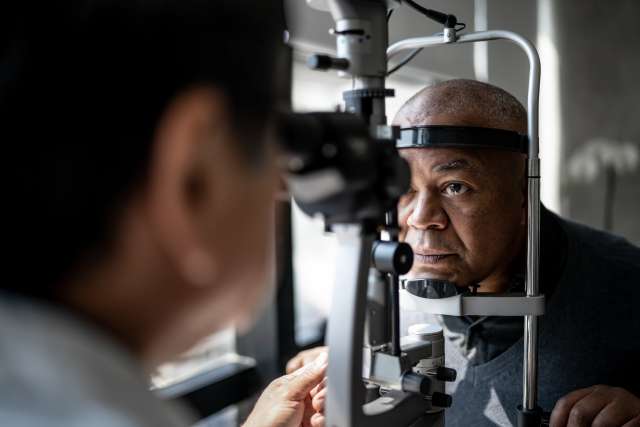It’s natural for vision to change with age. But how it changes and to what degree can depend on genetics, lifestyle, health and hormones.
While many of those factors can’t be changed, there are ways to protect your eyesight as you age — and the sooner, the better.
Here’s what you need to know about aging eyes:
Understanding age-related vision changes
Most people notice small changes in their eyesight around age 40. You may find it challenging to bring visual material into focus when it’s held too close to your eyes, or you may struggle to read a menu in a dim restaurant.
As you age, it’s common to develop difficulty with:
- Changing light levels, specifically taking longer to adjust to them
- Differentiating colors, especially when colors are similar, such as dark blue and black
- Leaking tears, often because of bright light, wind or changing temperatures
- Seeing up close, also known as presbyopia
Your eyes will continue to change as you age, but normal age-related eye changes are typically manageable with glasses, contact lenses or prescription medication. While your vision may change or worsen, these common changes shouldn’t cause you to lose your vision.
Eye conditions and diseases
Eye conditions and diseases that require medical treatment or surgery are not common, but your risk of developing one increases with age. Regularly seeing an optometrist (who provides primary eye care) or an ophthalmologist (who surgically treats eye disease) can help identify severe conditions early when they are easier to treat.
Your provider may recommend a dilated eye exam. Dilation involves widening your pupils (the dark center of your eye) using eye drops so your eye doctor can see further inside your eye. Getting your eyes dilated is painless and quick, and it’s the best way for eye specialists to detect disease or threats to your vision.
Your physician will check for eye diseases and conditions, such as:
- Age-related macular degeneration (AMD): AMD affects your central vision so that objects right in front of you appear blurry. That makes driving, reading or performing daily tasks difficult. It’s the most common cause of vision loss for older adults, but it can be treated with supplements, injections and laser treatment.
- Cataracts: These cloudy areas in your eye’s lens can blur your vision and get bigger without surgical treatment. Half of Americans over age 75 develop cataracts.
- Diabetic retinopathy: This disease affects people with uncontrolled diabetes and typically develops slowly with no warning signs. Advanced diabetic retinopathy can cause blurry vision, floaters and blindness, but it can be treated with laser surgery.
- Dry eye: If your tear glands aren’t working as they should, your eyes may sting, burn or feel like they have sand in them. This condition is most common in older women and treatment includes over-the-counter solutions, prescription medication or surgical procedures.
- Glaucoma: Pressure in your eye can damage the optic nerve in the back of your eye, causing glaucoma. It causes you to lose peripheral (side) vision and can lead to blindness if left untreated with drops, lasers or surgery. There are rarely early symptoms or pain, but people ages 60 and older are six times more likely to develop glaucoma.
Consult an eye care professional immediately if you have new or severe symptoms, including:
- Double vision
- Eye pain
- Floaters (spots) or flashes of light
- Inability to see
- Redness or swelling of the eye or eyelid
5 ways to protect aging eyes
You can’t prevent age-related vision changes. But proactively protecting your eyes and keeping them healthy may delay their onset. It can also help you prevent severe vision loss from eye disease.
Take these steps for healthier eyes:
1. Get regular check-ups with an eye care professional
The best thing you can do to protect your eyesight is to have an ophthalmologist or optometrist check your eyes regularly. The American Academy of Ophthalmology recommends a baseline dilated exam at age 40, and the National Institute on Aging suggests yearly exams starting at age 50 and exams every one to two years after age 65.
At every exam, be sure to:
- Check your current prescription: Even slight vision changes can lead to falls or injury.
- Go over your medication list: Some medications can affect your vision.
- Share or update your family history: A history of eye disease increases your risk of developing those conditions.
2. Eat for eye health
Vitamins and nutrients can protect and support healthy vision and eyes. To reap the benefits, eat a diet that contains:
- Lutein and zeaxanthin, which are part of plant pigments and found in leafy green vegetables, broccoli and colorful fruits such as raspberries and mangoes.
- Omega-3 fatty acids from fish such as anchovies, salmon and sardines
- Vitamin C, found in fruits and vegetables including broccoli, oranges, strawberries and tomatoes
- Vitamin E, found in healthy fats such as almonds, olive oil and avocadoes
- Zinc, which is abundant in beans, eggs, dairy, meat and seafood
3. Manage diabetes and high blood pressure
When left untreated or uncontrolled, diabetes and high blood pressure can cause eye problems. Let your eye specialist know about any health conditions you have and work with your primary care physician to find a treatment plan that works for you.
4. Protect your eyes outdoors
UV rays can damage every part of your eye. Exposure over time can damage your cornea, cause cataracts and lead to macular degeneration. You can also develop skin cancer on your eyelid and surrounding skin. To protect your eyes, wear sunglasses and brimmed hats whenever you are outdoors.
5. Stop smoking
Research shows that if you smoke, you may be more likely to develop AMD — up to four times more likely than nonsmokers. The good news is that as soon as you stop smoking, that risk drops. After 20 years of not smoking, your risk will be the same as if you never smoked.



